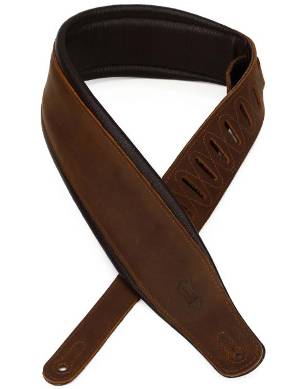Neck dive is when your guitar’s headstock feels heavier than the body, meaning you have more weight in your fretting hand and your headstock “dives” toward the floor when you let go of the guitar instead of staying in a playing position.
Neck dive happens when there’s an uneven balance of weight in your guitar, such that the center of gravity ends up somewhere along the neck instead of being between the two points that your straps attach to the body.
Some common/famous guitars that suffer from neck dive are the Gibson SG and Explorer range, the BC Rich Mockingbird and Stealth, and many smaller-body flying V guitars such as most Rhoads-style Vs.
While many opt to either live with it or avoid guitars with neck dive entirely, there are a few ways to either solve the problem or work around it. Let’s take a look.
Contents
Add Weights to Your Guitar

This is one of the most popular options because honestly, it’s the least “hacky” and is the most reliable as far as results.
Simply get a pack of adhesive wheel weights or similar and attach them inside the cavity of your guitar. This cavity is typically located below the bridge of the guitar, so right at the back of the body. This makes it an ideal point to counteract the weight of the neck.
People also use BBs or lead fishing weights in a sock, but you have to be very careful about having anything in there that could effect the guitar’s electronics. You can make a barrier using electrical tape, but the great thing about the wheel weights is they are coated, so no risk of any kind of short.
Add Weights to Your Strap
Like the above, this works by increasing the weight on the guitar body side. But this time instead of putting the weights inside the guitar, you can just attach them to the strap.
There are a couple of options here. For example, something like a velcro wrist weight for joggers is perfect. Just wrap it around your guitar strap at the bridge side of your guitar to balance out the weight of the heavier neck.
You can also get these “thru weights” for divers that you can just slide your strap through, though personally I would be concerned about them damaging the guitar’s finish.
Alternately, get some lead weights (again often used by divers) and sew them into a pouch in a good-quality leather guitar strap. Easy to swap on and off (eg if you want to sit with the guitar instead of standing), less invasive than putting weight inside the guitar, and potentially more balanced too.
Get a Wide or Grippy Strap
Another popular option for those with just a little neck dive is to get a strap that will grip to your shoulder a little better, thus stopping the neck from dropping. For this, you can look at either a wider strap, or better yet a strap with some sort of gripping material to the back that will hold things in place.
We recently tried out one of Levy’s 3″ wide leather straps and it was able to keep our SG in place with no issues. Being a very wide strap, it also made wearing something heavy like a Gibson Les Paul very comfortable, even for long stretches. Well worth checking out, and not just for neck dive.

Levy's 3" Wide Garment Leather Guitar Strap
Not only comfortable, but rock solid.
With a thick padded core, lived in looking pull up leather on the front, and garment leather on the underside, this strap not only kills neck dive dead, it's super comfortable doing it due to the wide distribution of the guitar's weight on your shoulder. A great option for neck dive for more than one reason.
Reduce the Weight at the Headstock
No, I’m not suggesting you cut off some of the headstock (though I’m sure some have gone so far). Those of us who use locking tuners know they can oftentimes weigh more than non-locking tuners. But even if you’re not using locking tuners, there may be some opportunity to reduce the weight at the headstock by swapping them out for something lighter. While you can find tuners with pearloid buttons rather than metal ones, you can also often find specially-made lightweight versions of many existing tuners.
While tuners on their own aren’t likely to be a silver bullet, combining this with a small amount of bodyweight or a new strap could solve your problems.
Move the Strap Buttons
This is where you get into more drastic measures, but also where you get the best bang for your buck.
Realistically, it’s the position of the strap buttons themselves that are the biggest cause of neck dive. Moving the neck-side strap button to a better location on the guitar will solve 99% of neck dive problems without adding any weight to the guitar or having to swap out tuners. Oftentimes a guitar with a strap button on its upper horn by the neck will balance like a charm once the button is moved to the heel.
That being said, before you take a drill to your guitar, experiment with moving your strap to various locations on the body of the guitar to ensure the move will have the effect you’re hoping for. A good strong gaffer tape will help in this situation.
Finally, if you do want to move the button to the horn but your guitar has a steel heel plate, you might want to consider just swapping out one of the screws from the plate for the screw that goes through the button. Just make sure it’s not too long or you’ll come out the other end.
Attach Your Strap to Your Belt
There are two other ways people deal with this issue, and both come down to using your belt. The simpler way is to loop your guitar strap through your belt on the bridge end. The slightly more involved version has you putting a carbiner on the strap and attaching that to your belt (or to the loop in your jeans).
In both instances, you’re looking for your belt to keep the guitar in place, though this is obviously hugely dependent on the height of your guitar.
Final Thoughts on Neck Dive
The funny thing about neck dive is everyone has their own way of dealing with it. Some people think weights are a no-brainer way to never have to think of it again, while others think that’s a bridge too far. Some swap out the tuners while other think it’s an expensive way to deal with a simpler problem.
So how about you – What do you do to deal with neck dive?


